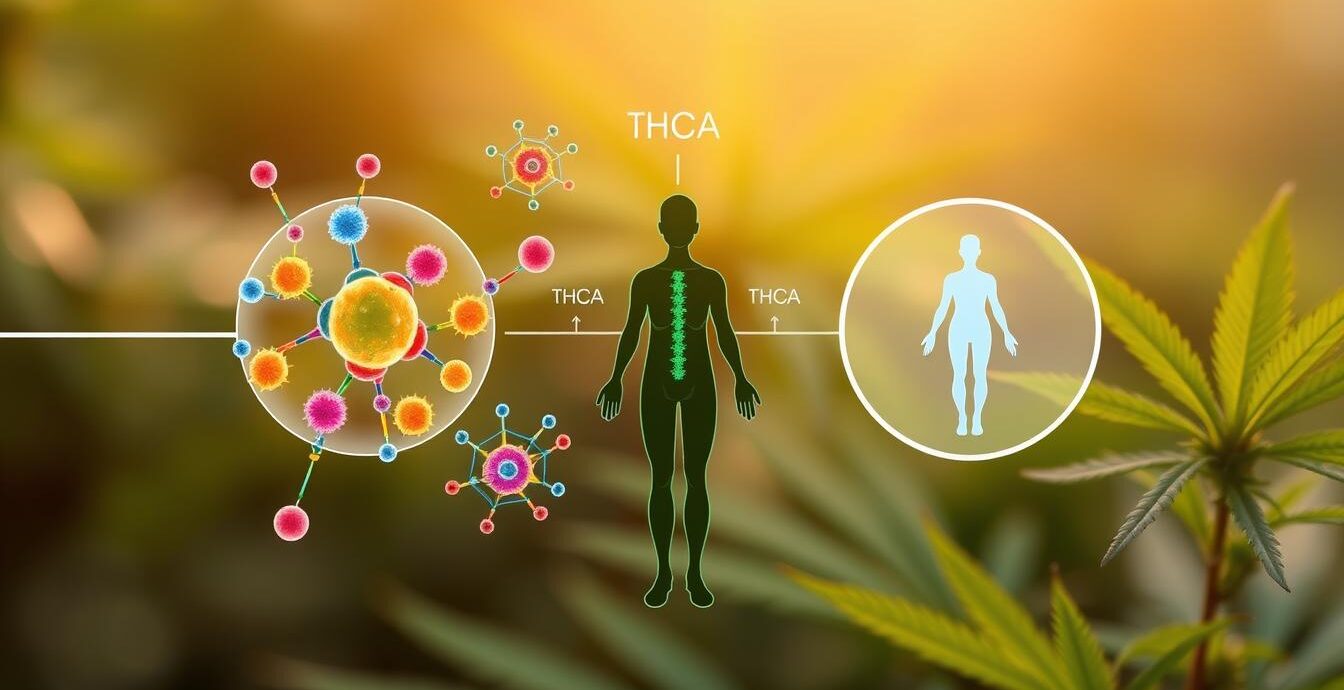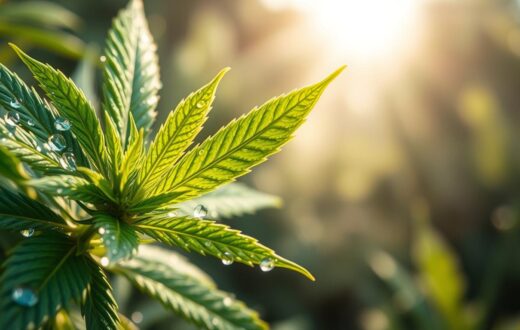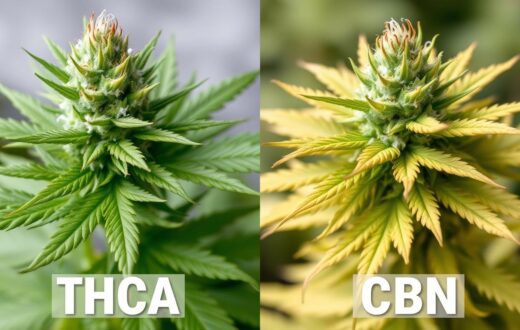Ever wondered how a non-psychoactive compound in raw cannabis could impact your body’s natural balance? The answer lies in the fascinating interaction between THCA and the endocannabinoid system.
THCA, or tetrahydrocannabinolic acid, is the precursor to THC found abundantly in raw cannabis plants. Unlike its famous cousin THC, THCA doesn’t produce a “high.” Yet, it plays a crucial role in maintaining our body’s equilibrium through its unique relationship with the endocannabinoid system.
This complex network of receptors and molecules spans our entire body, regulating various functions from mood to appetite. THCA’s interaction with this system is subtle but significant, potentially offering benefits without the intoxicating effects associated with marijuana use.
As we delve deeper into the world of cannabinoids, we’ll uncover how THCA’s chemical structure allows it to influence our body’s natural processes. We’ll explore its potential therapeutic applications and how it differs from other cannabis compounds. Stay tuned as we unravel the mysteries of THCA and the endocannabinoid system!
Introduction to THCA and the Endocannabinoid System
The cannabis plant has many compounds that interact with our bodies in special ways. THCA and the endocannabinoid system are key to understanding these interactions. Let’s dive into these elements and their importance in cannabis research.
What is THCA?
THCA, or tetrahydrocannabinolic acid, is a non-psychoactive compound found in raw cannabis. It’s the precursor to THC, a major phytocannabinoid in cannabis. When heated, THCA turns into THC, a process called decarboxylation. Unlike THC, THCA doesn’t cause intoxication, making it a focus for medical research.
Overview of the Endocannabinoid System
The endocannabinoid system is a complex network in our bodies that helps maintain balance. It includes endogenous cannabinoids, enzymes, and receptors. The two main types of receptors are CB1 and CB2 receptors. CB1 receptors mainly affect our mental state, while CB2 receptors regulate inflammation.
This system plays a role in many bodily functions, like mood, appetite, and pain sensation.
Importance of Cannabis Compounds
Cannabis compounds, including THCA and other phytocannabinoids, interact with our endocannabinoid system in different ways. These interactions can affect our health and wellness. For example, CBD, another major cannabinoid, is studied for conditions like anxiety and epilepsy.
Understanding how these compounds work with our bodies’ natural systems is crucial. It helps us explore their potential therapeutic uses.
Understanding THCA’s Chemical Properties
THCA is a key compound in cannabis plants. It has unique chemical properties that make it different from other cannabinoids. This non-psychoactive precursor to THC plays a crucial role in the plant’s biology and offers potential therapeutic benefits.
Molecular Structure of THCA
THCA’s molecular structure includes an extra carboxyl group. This distinguishing feature is responsible for its non-psychoactive nature. When exposed to heat, THCA undergoes decarboxylation, transforming into THC. This process explains why raw marijuana doesn’t produce a “high” but smoking or baking it does.
Differences Between THCA and THC
While THCA and THC are closely related, their effects on the body differ significantly. THCA doesn’t bind well with brain receptors, so it doesn’t cause intoxication. THC, on the other hand, interacts strongly with these receptors, leading to the psychoactive effects associated with marijuana use.
Benefits of THCA
Research suggests THCA may have anti-inflammatory, neuroprotective, and anti-emetic properties. Unlike THC, THCA offers these potential benefits without the “high.” This makes it an interesting subject for medical research, especially for those seeking the therapeutic effects of cannabis without psychoactive side effects.
Understanding these chemical properties helps us grasp the complex nature of cannabis and its compounds. It highlights the importance of studying individual cannabinoids to fully unlock the potential of this versatile plant.
The Role of Cannabinoids in the Endocannabinoid System
Cannabinoids are key in our body’s endocannabinoid system. This system controls many functions, like mood and appetite. The cannabis plant has 60 to 100 cannabinoids, each with special properties.
These plant-based compounds, called phytocannabinoids, work with our body’s own endogenous cannabinoids.
How Cannabinoids Function
Cannabinoids connect with specific receptors in our bodies. There are cb1 and cb2 receptors. CB1 receptors are mostly in the brain, in areas like the basal ganglia and hippocampus.
CB2 receptors are found in our immune system cells. This lets cannabinoids affect our nervous system and immune responses.
Interaction of Cannabinoids with Receptors
When cannabinoids bind to these receptors, they can cause different effects. THC, the main psychoactive part of cannabis, binds to CB1 receptors. This is why it makes us feel “high.”
CBD, another well-known cannabinoid, doesn’t bind directly but can still affect how other cannabinoids work with receptors. This can lead to effects like pain relief, reduced inflammation, and changes in mood or appetite.
Research on cannabinoids shows they might help with neurodegenerative diseases. With about 15 million people worldwide affected by neuromuscular diseases, cannabinoids could be very helpful. As we learn more, we might find new ways to use them for health.
THCA’s Interaction with CB1 Receptors
THCA is a key part of cannabis and works differently with our body’s systems. It doesn’t bind to CB1 receptors like THC does. Instead, it uses other paths in the body.
Mechanism of Action
THCA mainly works through CB1-independent mechanisms. It targets TRP channels and other non-cannabinoid receptors. This makes it different from THC, which directly activates CB1 receptors.
Implications for Neurological Health
THCA’s unique interaction with the body might help with neurological health. Early studies show it could help with epilepsy and neurodegenerative diseases. Its indirect effect on the endocannabinoid system might be why.
THCA flowers can have up to 40% THCA, which turns into THC when heated. This change, called decarboxylation, affects how cannabinoids work in our bodies. Knowing this is important for understanding THCA’s role in treating neurological issues.
THCA’s Interaction with CB2 Receptors
The endocannabinoid system is key to our body’s functions. THCA, found in raw cannabis, interacts with it in special ways. Let’s dive into how THCA works with CB2 receptors and its health benefits.
Mechanism of Action
THCA interacts with CB2 receptors differently than other cannabinoids. It doesn’t bind directly to these receptors like THC does. Instead, it affects the endocannabinoid system through other paths.
This unique approach changes how our body reacts to THCA. It’s especially important for inflammation and immune function.
Implications for Immune System Response
CB2 receptors are mostly in our immune system. THCA’s interaction with these receptors could greatly affect our body’s fight against inflammation. A 2011 study found that THCA might stop prostaglandin production, part of our inflammatory response.
This could explain why THCA has anti-inflammatory effects. It’s great news for those with immune-related health issues.
Research is ongoing, but THCA’s potential in managing immune disorders is promising. As we learn more about THCA and CB2 receptors, we might find new health uses. It’s an exciting area in cannabis and wellness research.
How THCA Affects Ailments and Conditions
THCA is found in raw cannabis plants and works differently with our bodies. It can help with many health issues without making you feel high. Let’s look at how THCA affects various conditions.
Anti-Inflammatory Properties
THCA might help reduce swelling in the body. This could be good for people with arthritis or inflammatory bowel diseases. It stops proteins that cause swelling, unlike THC.
THCA doesn’t make you feel high, making it safe for daytime use. This is a big plus for those looking for relief without the psychoactive effects.
Potential Neuroprotective Benefits
Research shows THCA might protect brain cells. This could help with conditions affecting the nervous system. Some studies suggest it might improve memory and focus.
These findings are exciting for future treatments using marijuana’s cannabinoids. They open up new possibilities for helping the brain and nervous system.
Impact on Pain Management
THCA might help with pain relief. It offers a new way to manage discomfort. Some people use THCA-rich cannabis products for chronic pain without the side effects of traditional drugs.
This makes THCA an interesting topic for both patients and researchers. It shows promise in understanding the endocannabinoid system better.
THCA and Its Potential Therapeutic Uses
The study of cannabis is growing fast. Scientists are finding new uses for different parts of the plant. THCA, found in raw cannabis, is being studied for its health benefits. It’s different from THC because it doesn’t make you high.
Research on THCA as a Medicine
Research shows THCA might fight inflammation well. This could help with arthritis and other inflammatory diseases. It doesn’t cause a high, making it good for those who want relief without feeling psychoactive.
Some studies also suggest THCA could help the brain and stop cancer cells from growing.
Comparison with Other Cannabinoids
THC is known for helping with pain and increasing appetite. But THCA might help in different ways. It could reduce inflammation and protect nerve cells.
CBD is another non-psychoactive cannabinoid that’s similar to THCA. Both hemp and cannabis have compounds that interact with our body’s own cannabinoids. But each has its own benefits. As we learn more, we see how these compounds can work together for better health.
Safety Profile of THCA
THCA is a cannabinoid found in hemp and cannabis plants. It offers unique benefits with fewer side effects than THC. This compound is one of the most abundant in marijuana, making it a focus for potential therapeutic uses.
Side Effects of THCA
THCA is generally well-tolerated by users. Unlike THC, it doesn’t cause psychoactive effects in its raw form. Some people might feel mild drowsiness or slight nausea.
It’s important to note that when heated, THCA converts to THC. This can lead to typical cannabis-related side effects.
Considerations for Use
When using THCA, there are several factors to keep in mind. First, be aware of potential drug interactions. Second, remember that THCA can convert to THC, which may cause you to fail a drug test. Lastly, check the legal status of THCA in your area before use.
Research suggests THCA might be more effective at reducing nausea than THC. It also shows promise for inflammation and neuroprotection. While THCA offers benefits like relaxation and discomfort relief, it’s crucial to use it responsibly and be aware of its effects on your body.
Cultivation and Processing of THCA-Rich Cannabis
To grow cannabis with lots of THCA, you need to pick the right strain and use special growing methods. THCA is found in raw marijuana plants. It’s not psychoactive like THC but might have health benefits.
Ideal Strains for High THCA Content
Some cannabis strains make a lot of THCA. These plants can have up to 30% THCA. Growers use special genetics and growing conditions to get more THCA. Hemp plants, on the other hand, can’t have more than 0.3% THC.
Methods of Preservation of THCA
Keeping THCA in cannabis is important for its benefits. Drying and curing carefully helps. Some producers freeze quickly to keep THCA levels high. Storing it cool helps prevent it from turning into THC.
Learning about growing and keeping THCA is key for those interested. As research goes on, we might find more ways to use THCA’s benefits.
Legal Status of THCA in the United States
The legal status of THCA in the U.S. is complex. THCA is a key compound in the cannabis plant. It interacts with the endocannabinoid system but doesn’t cause psychoactive effects like THC. Despite this, its legal status is unclear because of its connection to marijuana.
Current Regulations on THCA
THCA is in a legal gray area. The DEA classifies tetrahydrocannabinols, including THCA, as Schedule I controlled substances. This is because THCA can convert to THC, the psychoactive part of marijuana. The Farm Bill draft suggests banning intoxicating hemp-derived cannabinoids, which could change THCA’s status.
Implications for Research and Medical Use
The legal uncertainty around THCA affects research and medical use. THCA has shown promise for reducing inflammation and protecting the brain. But its classification limits thorough research. Some states allow cannabis for medical or recreational use, possibly including THCA products.
However, researchers and users must deal with different state laws and federal rules when using THCA.
The DEA is looking into changing cannabis’s legal status under the CSA. They might move it from Schedule I to Schedule III. This change could greatly help research and medical use of THCA, allowing for more studies on its benefits and how it works with the endocannabinoid system.
The Future of THCA Research and Discovery
The world of phytocannabinoids is changing fast, with THCA becoming a key area for medical study. Scientists are looking into this non-psychoactive compound found in cannabis and hemp.
Emerging Studies and Findings
Recent studies have shown THCA’s potential benefits. It might help with Alzheimer’s disease symptoms, which cause over 50% of dementia cases. Its interaction with the endocannabinoid system could lead to new treatments for this complex condition.
Potential for New Therapeutic Applications
THCA’s non-psychoactive nature makes it appealing for medical use. Scientists are studying its anti-inflammatory and neuroprotective effects. These could lead to new treatments for epilepsy and chronic pain.
The CBD pet market, worth $257.6 million in 2023, shows growing interest in cannabis-based products. As research continues, we might see THCA-based treatments approved by the FDA. Its interaction with cannabinoid receptors could open up new medical possibilities.
Conclusion
As we finish our look at THCA and the endocannabinoid system, it’s clear that cannabis has many benefits. THCA, the non-psychoactive form of THC, is especially interesting. It’s a key player in the world of cannabinoids.
Summary of THCA and the Endocannabinoid System
THCA works with our body’s endocannabinoid system in special ways. It could help us without making us feel “high.” This form of THC is found in fresh cannabis and hemp.
Unlike THC, THCA doesn’t connect with CB1 receptors in the brain. This makes it a good choice for those who want relief without getting high.
Final Thoughts on Future Directions
Research on THCA is looking bright. Scientists are looking into its effects on inflammation, brain health, and nausea. As we learn more, THCA might help treat epilepsy and other diseases.
THC has been studied a lot, but THCA needs more research. This will help us understand its full effects and long-term benefits.
As laws change, we might see more THCA products available. This could lead to new uses in medicine and wellness. The study of THCA and the endocannabinoid system is just starting. We’re eager to see what new discoveries will come.















